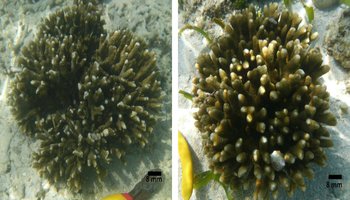VOLUME 7 NUMBER 2 (July to December 2014)

Philipp. Sci. Lett. 2014 7 (2) 293-299
available online: August 15, 2014
*Corresponding author
Email Address: hentyap@yahoo.com
Received: May 9, 2014
Revised: June 18, 2014
Accepted: June 18, 2014
SHORT COMMUNICATION
Biochemical comparison of bleaching and non-bleaching Montipora digitata (Order Scleractinia) in the Philippines
¹The Marine Science Institute, University of the Philippines, Diliman, 1101 Quezon
City, Philippines
Populations of bleaching (B) and non-bleaching (NB) Montipora digitata (Dana, 1846, Order Scleractinia) inhabit similar zones, with similar temperature ranges, in the reef of Bolinao in the northwestern Philippines. Colonies of the former (B) have been observed to bleach during periods of elevated sea surface tem- peratures and calm waters, and have declined in abundance over recent years. Biochemical analyses revealed significantly higher amounts of chlorophyll-a in the NB colonies compared to the B. The kinds and quantities of mycosporine-like amino acids were not significantly different between the two, except for palythine which was higher in the NB corals, and palythene which was more abundant in the B. The greater quantities of chlorophyll-a in the tissue of NB corals indicate higher abundances of symbi- otic zooxanthellae, and the likely importance of building up nu- tritional reserves in order to overcome environmental stress. An additional consideration concerns the possible role of palythine in bleaching resistance.
© 2024 SciEnggJ
Philippine-American Academy of Science and Engineering